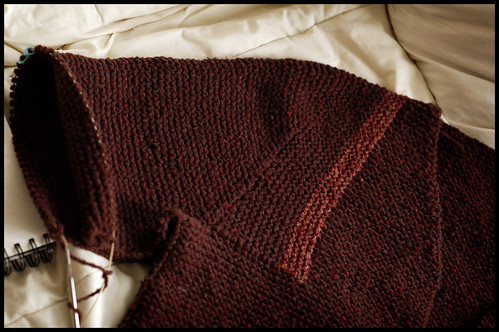At present, I estimate that I have about 60% of the knitting done. Although hoods, I assume, eat up more wool than most of us expect, so my calculations are subject to interpretation. The body is knit in its entirety as well as 2 sleeve caps, only one of which will make it to the final version of the sweater.
In conceiving an adaptation of the original Tomten, there were a few areas of the pattern that I knew would need some serious revision to fit my personal taste. The most obvious and problematic for me being the sleeve construction. The current pattern has a schematic that resembles a capital "T", utilizing a sort of very-deep modified drop shoulder. [Here's a good example I found searching flickr.] Now, not forgetting that this pattern is best suited (not to mention intended) for children, this construction is fine and in fact a truly "modular" one, which is by all means part of the Tomten's charm. For me, it won't work though and I welcomed the challenge of figuring something else out while keeping the main design principles intact.
I schemed up a few ideas for tackling this problem, one of them involved a gusset, others involved short rows and still others a combination of these and other tricks. In the end, I decided to try the most interesting thing I could come up with - working a set-in sleeve from the top down in the (somewhat odd) space provided. I wasn't sure if it would work, mostly because of all that garter stitch, which has a completely different row-to-stitch-gauge ratio than stockinette. And I've only ever seen this technique successfully executed in stockinette.

Pictured above is the armhole just before the set-in sleeve shaping begins (aka boatloads of shortrows). I've blogged this trick before - it's one of the genius techniques found in Barbara Walker's book of all things top-down - and an addictive little trick. (Hark, heel-turners of the world, this one is right up your alley.) Remember, it saved me from pattern issues I ran into with Jarrett.
The difference with this situation is, as I mentioned before, an atypical gauge ratio. Since the 'turning' of the sleeve fuses together a horizontal gauge measurement with a vertical gauge measurement within one cylindrical tube, garter stitch threw my numbers off. Following the top-down method as-is, I would have ended up with the upper portion of the sleeve at almost 50% of the body. WAY too many stitches. (In this case, that meant an upper arm circumference of about 21"!) The standard sleeve usually maxes out at the upper arm around 35-40%.

In an nutshell, I devised a rate of increasing to be worked throughout the short row shaping of the sleeve cap that more or less lands me at the target 35-40% sleeve number at the conclusion of the shaping. I'm sure this is not nearly as complicated as I've made it sound. Either way, the second picture is the successful cap and the beginning of the regular sleeve knitting (from the top-down, naturally).
Now I just have to replicate this on the opposite side (can I decipher my notes?), finish the sleeves and then it's on to the hood. The hood is really what's gonna power me through sleeve monotony. Lord knows I've had some other fiber related distractions tempting me.
Garter stitch resumes with an almost untarnished voracity. Stay tuned for more Adult Tomten coverage.


